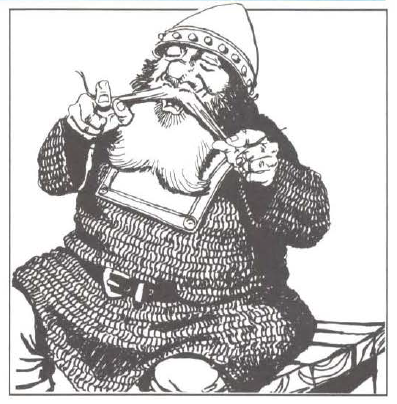World-Building: The Dwarves
Elfland’s Ethics & World Building | World-Building: Causes & Consequences | World-Building: Geneses | World-Building: About Alignment | World-Building: The False Light | World-Building: The Elves | World-Building: Rules Changes I
Nota Bene: Some of the details below may seem less detailed than necessary. If so, it’s likely because I’m still working the answers to a few questions.
Isarn Egni, the Forge Lord, mined iron from the depths of the First Mountain. He purified the metal with the heat of his gaze and hammered it on the Dread Anvil into the forms of Heled and Murgeda, the first dwarves. Isarn Egni granted his creatures life by plunging them into pure spring water untouched by sunlight. He then gave Heled and Murgeda dominion over all lightless places as well as the lands surrounding the entrances to the World-Under.
During the Second Age, dwarven culture reached its pinnacle. The dwarves expanded westward across the Duna, driving the elves from their cities and liberating the humans whom the elves had ruled. Dwarves built and controlled the most powerful cities, crafting an empire that radiated out from Ironspyre, the mightiest dwarven mountain home. Dwarven hegemony shattered during the Gargarizein, when gargoyles erupted from World-Under into the Deeps to overrun several major dwarven strongholds. Thousands of dwarf warriors died defending their domains. Thousands more abandoned their homes when it became clear hope was lost.
Today, dwarves are uncommon. The surviving clans have scattered, forming enclaves in a handful of cities along the Duna, the great river that separates the Western Lands from the plains beneath the Sundered Chain, that range of mountains that was once the backbone of dwarven military and political power. Within these enclaves, dwarven guilds dominate all aspects of metalworking while the scions of once-great clans dream of reclaiming their ancient mountain halls.
Prime Requisite: Strength
Level Limit: 12
Multi-Class Options: Cleric, Paladin, Thief
Dwarf Special Abilities
These special abilities replace those described in the standard rules.
Armor and Weapons: Dwarves can wear any armor and use shields. They may use any weapon of normal or small size, but may use neither two-handed swords or longbows.
Dark Sight: Dwarves can see in total (nonmagical) darkness as if it were bright light. In dim light or night-time conditions, their vision is limited to 120 feet, and they lose the ability to discern color, seeing everything in black, white, and shades of gray. Dwarves have their vision further reduced to 60 feet in bright light, and they suffer a -1 on their “to hit” rolls in such conditions.
Languages: Dwarves speak Common and Dwarven. If they speak any additional languages, the first choice must be Garg, Goblin, or Orc.
Mettle of Metal: Dwarves possess remarkable toughness. Nonmagical fire inflicts -2 points of damage per damage die (with a minimum of 0 points per die). Magical fire inflicts -1 point of damage per damage die (with minimum of 1 point per die). Dwarves take 1 fewer points of damage from cutting or slashing attacks (to a minimum of 1 point of damage).
Skilled: When making an ability check related to metalwork, mining, or stonework, reduce the difficulty by 1d6.
Stout: A dwarf’s tactical movement is not affected by encumbrance to the same extent other races experience.


Leave a Reply